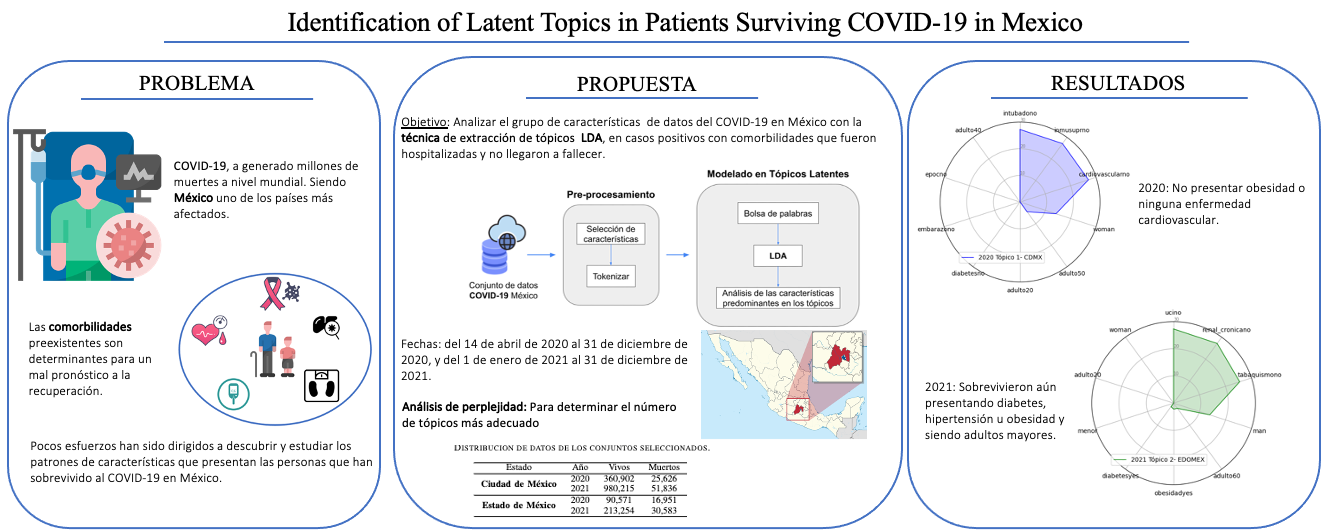Identification of Latent Topics in Patients Surviving COVID-19 in Mexico
Keywords:
Latent topics, Latent Dirichlet Allocation (LDA), COVID-19, Risk factorsAbstract
With the outbreak of the SARS-CoV-2 o COVID-19 pandemic, multiple studies of risk factors and their influence on patient deaths have been developed. However, little attention is often paid to analyzing patients in risk groups despite the fact that they have been infected and inpatients can survive. In this article, with the dataset available from the Ministery of the health of Mexico, this paper proposes the use of the latent topic extraction algorithm Latent Dirichlet Allocation (LDA) for the study of COVID-19 survival factors in Mexico. The results let us conclude that in the year before strategies for prevention and control of COVID-19, the latent topics support that patients without comorbidities have a low risk of death, compared with the period of 2021, wherein in spite of having some risk factors patients can survive.
Downloads
References
W. Liu, C. Yang, Y. Liao, F. Wan, L. Lin, X. Huang, B. Zhang, Y. Yuan, P. Zhang, X. Zhang, Z. She, L. Wang, and H. Li, “Risk factors for COVID-19 progression and mortality in hospitalized patients without pre-existing comorbidities,” J. Infect. Public Health, vol. 15, no. 1, pp. 13–20, 2022.
J. Tardif, M. Cossette, M. Guertin, N. Bouabdallaoui, M. Dubé, and G. Boivin, “Predictive risk factors for hospitalization and response to colchicine in patients with COVID-19,” Int. J. Infect. Dis., vol. 116, pp. 387–390, 2022.
P. Liu, A. Blet, D. Smyth, and H. Li, “The Science Underlying COVID- 19 Implications for the Cardiovascular System,” Circulation, vol. 142, no. 1, pp. 68–78, 2020.
J. Tian, X. Yuan, J. Xiao, Q. Zhong, C. Yang, B. Liu, Y. Cai, Z. Lu, J. Wang, Y. Wang, S. Liu, B. Cheng, J. Wang, M. Zhang, L. Wang, S. Niu, Z. Yao, X. Deng, F. Zhou, W. Wei, Q. Li, X. Chen, W. Chen, Q. Yang, S. Wu, J. Fan, B. Shu, Z. Hu, S. Wang, X. Yang, W. Liu, X. Miao, and Z. Wang, “Clinical characteristics and risk factors associated with COVID-19 disease severity in patients with cancer in Wuhan, China: a multicentre, retrospective, cohort study,” Lancet Oncol., vol. 21, no. 7, pp. 893–903, 2020.
Q. Pham, D. Nguyen, T. Huynh-The, W. Hwang, and P. Pathirana, “Artificial intelligence (ai) and big data for coronavirus (covid-19) pandemic: A survey on the state-of-the-arts,” IEEE Access, vol. 8, pp. 130820–130839, 2020.
Z. KARHAN and F. AKAL, “Covid-19 Classification Using Deep Learning in Chest X-Ray Images,” in TIPTEKNO, (Virtual), pp. 1–4, 2020.
F. Ucar and D. Korkmaz, “COVIDiagnosis-Net: Deep Bayes-Squeezenet based diagnosis of the coronavirus disease 2019 (COVID-19) from X-ray images,” Med. Hypotheses, vol. 140, p. 109761, 2020.
E. Cortés and S. Sánchez, “Deep learning transfer with alexnet for chest x-ray covid-19 recognition,” IEEE Lat. Am. Trans., vol. 19, pp. 944–951, Jun. 2021.
M. Tandan, Y. Acharya, S. Pokharel, and M. Timilsina, “Discovering symptom patterns of COVID-19 patients using association rule mining,” Comput. Biol. Med., vol. 131, p. 104249, 2021.
N. Uma, A. Arulanandham, G. Keerthy, and N. P. B, “A novel approach for tracking the spread of covid-19 disease and discovering the symptom patterns of covid-19 patients using association rule mining,” in ICONAT,
pp. 1–6, 2022.
S. Katragadda, R. Gottumukkala, R. Bhupatiraju, A. M. Kamal, V. Raghavan, H. Chu, R. Kolluru, and Z. Ashkar, “Association mining based approach to analyze covid-19 response and case growth in the united states,” Sci. Rep., vol. 11, no. 1, p. 18635, 2021.
S. Shurrab, Y. Shannak, A. Almshnanah, H. Khazaleh, and H. Najadat, “Attitudes evaluation toward covid-19 pandemic: An application of twitter sentiment analysis and latent dirichlet allocation,” in 12th ICICS, (Valencia, Spain), pp. 265–272, 2021.
D. M. Blei, A. Y. Ng, and M. I. Jordan, “Latent dirichlet allocation,” Journ. mach. Learn. research, vol. 3, no. Jan, pp. 993–1022, 2003.
P. Koukaras, C. Tjortjis, and D. Rousidis, “Mining association rules from covid-19 related twitter data to discover word patterns, topics and inferences,” Inf. Syst., vol. 109, p. 102054, 2022.
R. Fernandez-Beltran and F. Pla, “Latent topics-based relevance feedback for video retrieval,” Pattern Recognit., vol. 51, pp. 72–84, 2016.
H. Paiva, R. Magalhães-Afonso, D. Sanches, and F. Ribeiro-Pelogia, “COVID-19 Trend Analysis in Mexican States and Cities,” in 43rd EMBC, (Virtual), pp. 1820–1823, 2021.
V. Suárez, M. Suarez-Quezada, S. Oros-Ruiz, and E. Ronquillo-De-Jesús, “Epidemiology of COVID-19 in Mexico: from the 27th of February to the 30th of April 2020,” Rev. Clin. Esp., vol. 220, pp. 463–471, 2020.
I. Núñez, Y. Caro-Vega, and P. Belaunzarán-Zamudio, “Diagnostic precision of local and world Health Organization definitions of symptomatic COVID-19 cases: an analysis of Mexico’s capital,” Public Health, vol. 205, pp. 187–191, 2022.
J. A. Guzmán-Torres, E. M. Alonso-Guzmán, F. J. Domínguez-Mota, and G. Tinoco-Guerrero, “Estimation of the main conditions in (SARS-CoV-2) Covid-19 patients that increase the risk of death using Machine learning, the case of Mexico,” Res. Physics, vol. 27, p. 104483, 2021.
D. M. Blei, “Probabilistic topic models,” Commun. ACM, vol. 55, no. 4, pp. 77–84, 2012.
S. Dahal, R. Luo, M. H. Swahn, and G. Chowell, “Geospatial Variability in excess death rates during the COVID-19 pandemic in Mexico: Examining Socio Demographic, Climate and Population Health Characteristics,” Int. Jour. Infec. Diseases, vol. 113, pp. 347–354, 2021.
V. Principe, R. de Souza-Vale, J. de Castro, L. Carvano, R. Henriques, de V.J. Almeida e Sousa Lobo, and de R. Alkmim Moreira Nunes R., “A Computational Literature Review of Football Performance Analysis through Probabilistic Topic Modeling,” Artif. Intell. Rev, p. 1–21, 2021.
M. Sánchez-Talanquer, E. González-Pier, J. epúlveda, L. Abascal-Miguel, J. Fieldhouse, C. del Río, and S. Gallalee, “La respuesta de méxico al covid-19: Estudio de caso,” Institute for Global Health Sciences, 2021.


